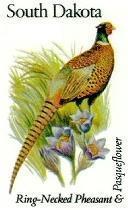
Ring-Necked Pheasant
(Phasianus culchicus)
Adopted on February 13, 1943.
The Chinese ring-necked pheasant is the state bird. It was introduced to South Dakota in 1898 and is easily recognized by its colorful plumage. It is also known for its delicious meat. Since it is primarily a Midwestern bird, pheasant is considered a delicacy in many other states.
No game species introduced to this continent has been as successful as the ring-necked pheasant. One of more than 40 species originating in Asia and Asia Minor, these birds from the genus Phasianus are perhaps better known than any of the other 15 groups of pheasants in the world. All are related to the partridges, quails, grouse and guinea-fowls which make up the order Galliformes or chicken-like birds.
Archeological evidence suggests that large pheasants lived in southern France in the Miocene period, some 13 million years ago. The Greeks knew the bird in the 10th Century B.C. and we have adopted their name for the species, Phasianus ornis (phasian bird), derived from the Phasis River (now Rion) near the Caucasus Mountains. The Chinese knew the pheasant some 3,000 years ago, but the Romans are considered responsible for the spread of pheasants in western Europe. When Julius Caesar invaded England in the first century B.C., the pheasant followed.
It wasn't until 1733 that the pheasant appeared in North America, when several pairs of the black-necked strain were introduced in New York. Other pheasant varieties were released in New Hampshire and New Jersey later in the 18th century. Not until 1881, when Judge O.N. Denny released some 100 pairs of Chinese ring-necks in the Willamette Valley of Oregon, did the pheasant really gain a foothold in the United States. Since then, pheasants have been propagated and released by government agencies, clubs and individuals, and for all practical purposes are established everywhere on the continent that suitable habitat exists.
Identification Tips
- Length: 27 inches
- Chunky, long-tailed, round-winged, ground-dwelling bird
- Small head and thin neck
- Immatures similar to adult female
- Some subspecies have green body or white wings, but are very locally introduced
Adult male
- Green head
- Pale bill
- Unfeathered red facial skin around eye
- White ring around neck
- Golden plumage with bluish and greenish iridescence and black spots scattered throughout
- Long, pointed, golden tail feathers with black barring
- Spurred legs
Adult female
- Buffy brown head and underparts
- Dark brown back with paler edgings and centers
- Black spots and bars scattered about head, neck and flanks
- Long, buff-brown, pointed tail
- Lacks spurs
|
|
| Kingdom |
Animalia -- animals |
| Phylum |
Chordata -- chordates |
| Subphylum |
Vertebrata -- vertebrates |
| Class |
Aves -- birds |
| Order |
Galliformes -- fowls, gallinaceous birds |
| Family |
Phasianidae -- grouse, pheasants, quail |
| Genus |
Phasianus Linnaeus, 1758 -- pheasants |
| Species |
Phasianus colchicus Linnaeus, 1758 -- Faisán de collar |